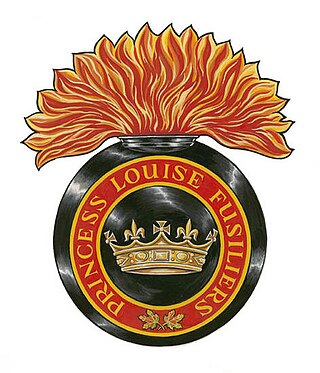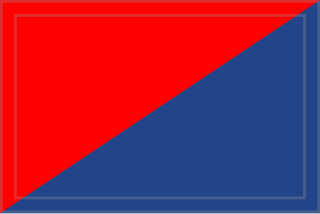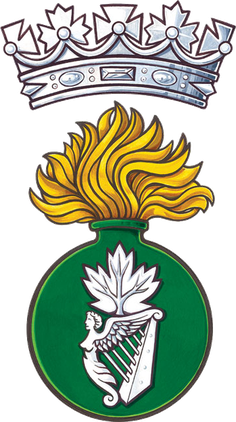
The 1st Canadian Division is a joint operational command and control formation based at CFB Kingston, and falls under Canadian Joint Operations Command. It is a high-readiness unit, able to move on very short notice, and is staffed and equipped to meet Canada's military objectives to counter any potential threat.

The 3rd Canadian Division is a formation of the Canadian Army responsible for the command and mobilization of all army units in the provinces of Manitoba, Saskatchewan, Alberta and British Columbia, as well as Northwestern Ontario including the city of Thunder Bay.

The 4th Canadian Division is a formation of the Canadian Army. The division was first created as a formation of the Canadian Corps during the First World War. During the Second World War the division was reactivated as the 4th Canadian Infantry Division in 1941 and then converted to armour and redesignated as the 4th Canadian (Armoured) Division. Beginning in 1916 the division adopted a distinctive green-coloured formation patch as its insignia. In 2013 it was announced that Land Force Central Area would be redesignated 4th Canadian Division. It is currently responsible for Canadian Army operations in the Canadian province of Ontario and is headquartered at Denison Armoury in Toronto.

The 5th Canadian Division is a formation of the Canadian Army responsible for the command and mobilization of most army units in the provinces of New Brunswick, Nova Scotia, Prince Edward Island and Newfoundland and Labrador; as well as some units in Kingston, Ontario. The division is recognized by the distinctive maroon patch worn on the sleeve of its soldiers.

The Nova Scotia Highlanders is an infantry regiment in the primary reserve of the Canadian Army. It is part of 36 Canadian Brigade Group, 5th Canadian Division.

The Royal Highland Fusiliers of Canada is a Primary Reserve light infantry regiment of the Canadian Army, with companies in Cambridge and Kitchener, and is an infantry sub-unit of 31 Canadian Brigade Group, headquartered in London, Ontario. The Princess Margaret, Countess of Snowdon, and The Prince Andrew, Duke of York, as members of the Canadian Royal Family, acted as Colonel-in-Chief.

The Lorne Scots is a Primary Reserve infantry regiment of the Canadian Army. It is part of the 4th Canadian Division's 32 Canadian Brigade Group.

The Princess Louise Fusiliers is a Primary Reserve light infantry regiment of the Canadian Armed Forces. Formed as 66th The Halifax Battalion of Infantry and then named 66th Battalion after Princess Louise in 1879, it took its present name in May 1920. The 6th Machine Gun Battalion, CMGC amalgamated with the regiment in 1936

The 5th Canadian Infantry Brigade was an infantry brigade of the Canadian Army that fought during World War I and World War II. Raised in 1915, it formed part of the 2nd Canadian Division and fought on the Western Front during World War I before being disbanded. Later, it was re-raised in September 1939 and subsequently took part in Allied operations in north-west Europe in 1944 and 1945.

The 7th Canadian Infantry Division was an infantry division of the Canadian Army, mobilized in the spring of 1942 and assigned for home defence within Atlantic Command, during World War II.

The 6th Canadian Infantry Division was an infantry division of the Canadian Army, formed in 1942 during the Second World War. It was attached to Pacific Command. The division had a brigade sent to the Aleutian Islands Campaign, particularly at Kiska, but never saw action. The 6th Division was to have been part of a proposed Commonwealth Corps, formed for a planned invasion of Japan, but was disbanded on 31 January 1946, after the surrender of Japan in August 1945.

The Highland Light Infantry of Canada was an infantry regiment of the Canadian Army. In 1965, the regiment was amalgamated with The Scots Fusiliers of Canada to form The Highland Fusiliers of Canada.
All units of the Canadian Armed Forces have an order of precedence that determines seniority; it often decides such matters as which unit forms up to the right of other units on a ceremonial parade, or the order in which marches or calls are played at a mess dinner.
The 2nd Canadian Infantry Brigade was a formation of the Canadian Army that served in both World War I and World War II. The brigade fought on the Western Front during World War I, and in Sicily and Italy during the Second World War. In both wars, the brigade formed part of the 1st Canadian Division.

The Cape Breton Highlanders is an infantry regiment of the Canadian Army. It was established in 1871, merged into The Nova Scotia Highlanders in 1954, and re-established as a distinct regiment in 2011. It is part of the 5th Canadian Division's 36 Canadian Brigade Group and is headquartered at Sydney, Nova Scotia.
The 1st Canadian Infantry Brigade was a Canadian Army formation that served with the 1st Canadian Division in World Wars I and II. In 1953 it was reformed in Germany to become the 1 Canadian Mechanized Brigade Group in 1992.
The Edmonton Fusiliers was an infantry regiment of the Non-Permanent Active Militia of the Canadian Militia and later the Canadian Army. First raised in 1908 as part of the 101st Regiment Edmonton Fusiliers, it became a separate regiment in 1924 when The Edmonton Regiment was split into two separate regiments. In 1946, the regiment was Amalgamated with the 19th Alberta Dragoons.

Canadian-Scottish regiments are regiments in the Canadian Army that maintain the traditions and style of dress used by Scottish regiments. Although these units maintain Scottish dress and traditions, recruitment for these units is open to all Canadians.

The Irish Fusiliers of Canada (The Vancouver Regiment) was an infantry regiment of the Canadian Army. It was placed on the Supplementary Order of Battle in 1965. In 2002, it was taken off the Supplementary Order of Battle and amalgamated with The British Columbia Regiment (Duke of Connaught's Own).
The 13th Canadian Infantry Brigade was a formation of the Canadian Army that served in both World Wars. During World War I, the brigade formed part of the 5th Canadian Division. However, the 13th Brigade never saw combat as the brigade along with the 5th Canadian Division was broken up to provide reinforcements to the 4 other divisions of the Canadian Corps. During the Second World War, the brigade formed part of the 6th Canadian Infantry Division serving on the west coast in the home defence role and in June 1943, the brigade took part in Operation Cottage on Kiska during the Aleutian Islands campaign.













